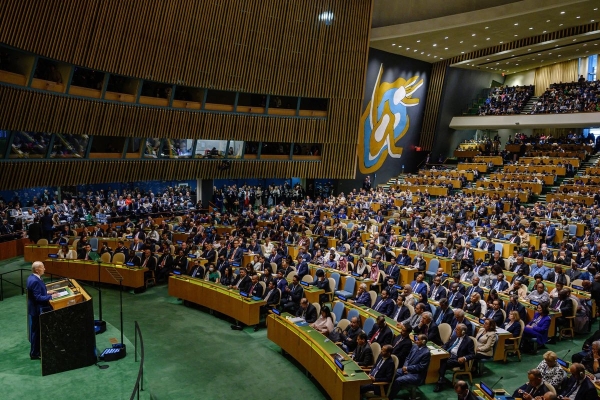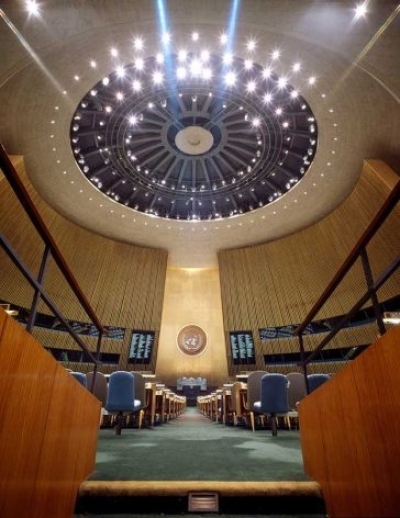The Biden administration has chosen to organize its entire foreign policy around countering China. And it is a choice, one that leaves countries forced to decide which side they are on, in what could become a dangerous replay of the last Cold War.
Except President Joe Biden and his team vehemently deny that that’s the case.
“Now, let me be clear: None of these partnerships are about containing any country,” Biden said at the United Nations General Assembly last week, talking about the many foreign policy initiatives of his administration that overtly and implicitly are about countering China. “We seek to responsibly manage the competition between our countries so it does not tip into conflict.”
The administration, however, has yet to fully articulate what constructive competition might look like in practice. And so it seemed that every world leader visiting New York for the United Nations’ annual meeting was asked to pick a side. In a week of interviews, panels, and private events on the sidelines of the UN, I heard variations of that question, over and over. “Hopefully things can subside. The tension is now creating anxiety in the region,” Malaysian Prime Minister Anwar Ibrahim said. “We believe that both relationships can coexist and flourish simultaneously,” Prime Minister Anwaar-ul-Haq Kakar of Pakistan said.
But do Washington and Beijing believe that?
“Both sides see themselves in a zero-sum competition and an existential ideological struggle,” writes Paul Heer, a former US intelligence official, in The National Interest. “What can break the cycle of miscommunication, mutual miscomprehension, and mutual recrimination between the United States and China?”
Which side are you on?
The fear is taking shape among foreign policy experts in the United States and across the world that a new Cold War with China could be locked in for decades. In Washington, Republicans and Democrats agree on little today, with the exception of the looming threat posed by China militarily and economically. Under that view, China constitutes an urgent challenge to the US and international stability, and both domestic and foreign policy need to be focused on containing Beijing’s global reach and economy. For Beijing, US financial and military might is hemming in China’s emergence as a global power, and President Xi Jinping is increasingly willing to confront that in diplomatic avenues.
Though the Biden administration has been dominated by tricky foreign policy crises, it does appear that the way China has been framed is a potential problem of Washington’s own making.
One can acknowledge the threat that China presents without making that the organizing principle of a president’s foreign policy. Though Biden said in as many words that countries don’t have to pick a side, that question is still being forced upon every world leader.
On the sidelines of the United Nations General Assembly, some of the questions were warranted — like one raised to Pakistan’s leader, a country that buys about 80 percent of its arms from China while also being a partner of the US.
“Pakistan has successfully maintained good relations with both the US and China in the past, and would continue to do so,” Pakistan’s caretaker prime minister, Anwaar-ul-Haq Kakar, told the Council on Foreign Relations (CFR).
The Pakistani leader also made an unfortunate turn of phrase — “We are very clear that there are people who would qualify Pakistan as China’s Israel” — implying that it would have China’s back in the event of a hot conflict and apparently echoing a remark from a Chinese general. It’s not exactly the type of comment that wins love in American foreign policy circles.
Other countries were more tactful in navigating the two superpowers.
Malaysia sees China as an important neighbor, and it’s the country’s top trading partner, while it holds out the US as a longtime ally with shared values. “We manage this as a small country. I can’t change the world. I can at least assure them that we will continue with this relationship to the benefit of both,” Malaysian Prime Minister Anwar Ibrahim said to CFR members.
Everyone is being asked to say where they stand, even when it’s clear. In a private panel I attended, the question was even put to an official from a Middle Eastern country that couldn’t be a closer partner to the US.
Germany now has its own China strategy, which Secretary of State Antony Blinken notes is “very coincident with our own.” Blinken says that’s because “it reflects something that we’ve seen around the world, both in Europe, in Asia, as well as in the United States, which is a growing convergence in our approaches to China.” But that convergence is also being driven by the US itself, which is pushing its traditional partners to buddy up to save the world from the perceived threat of China. It’s almost as if the US is letting China define its policies internationally.
Many of the US’s close partners are similarly concerned about China’s emergence as a superpower and the risks it poses to their economies or territory. Yet in the US, the focus seems exclusively to be about doubling down on alliances to offset China — with the UK and Australia, with Japan and South Korea, with the Quad, to name a few — rather than thinking through other shared global challenges.
NATO is becoming a vehicle for such deterrence, too. Last year the military alliance noted the threat of China for the first time in its Strategic Concept document.
Ukraine is struggling to advance a counter-offensive and push Russia out of occupied territory. At the onset of the invasion, many analysts argued that if the West didn’t support Ukraine then it would pave the way for Chinese aggression against Taiwan. I’m not entirely sure framing this conflict so narrowly around what it will mean for China’s calculus is very helpful or enlightening, but that’s exactly what NATO Secretary General Jens Stoltenberg did at CFR, saying, “It is in the security interest of the United States to ensure that Ukraine wins and make it easier to deal with China.”
That might be a useful rhetorical tactic to gain attention for long-haul support for Ukraine, but it also sets up zero-sum stakes.
Could competition be constructive?
The US has also amped up engagement with small countries in the Asia/Pacific that are geopolitically ensnared between Washington and Beijing. It’s why President Biden visited Vietnam after the G20 summit in India and why members of his cabinet are spending more time in the region.
The focus is almost entirely on countering China. “The Pacific deserves greater attention and resources from the US, but the kind of attention and resources that follow ‘great-power competition’ can be perilous,” the scholar Van Jackson notes.
This week, for example, the US established diplomatic relations for the first time with the small Pacific nations of the Cook Islands and Niue.
A senior Biden administration official told reporters, “The way that we like to think about it is that our engagement with the Pacific Islands is really not about who we are against but what we are for.” For the White House, the affirmative vision here is that “our national interests are tied to a free, open, vibrant, and dynamic Pacific region and that the United States is a Pacific power that is here to stay,” as that official continued.
But “free, open, vibrant, and dynamic Pacific,” is code for pushing back China.
And let’s be honest: The US would not be putting diplomatic energy into recognizing a country with a population of less than 18,000 and 2,000, respectively, if not for the perceived threat of China. Secretary of State Blinken would not have visited Fiji in February 2021, as US intelligence officials warned of an imminent Russian invasion of Ukraine, if not for the perceived threat of China.
When countries caught in between see the choice put before them, it could start to feel like a “with us or against us” moment. The world is not currently divided into blocs like it was during the Cold War. But there’s a real risk that we could start replicating those dynamics.
So it’s incumbent upon us to ask: What would constructive competition look like?
Competition to address the climate catastrophe, whether through clean energy pathways or reducing emissions. A race to the top! Competing for nuclear arms control and nonproliferation. A contest for whether the US or China can get more Covid boosters in arms more quickly, and in the process strengthen the global health system. No one wants to see a Chinese invasion of Taiwan. But climate change and pandemics pose as great a threat to Americans as a war.
Maybe China isn’t interested in participating in any of this. And if constructive competition isn’t a feasible option, then maybe it’s time for Biden to say that clearly — the US has tried every option, sent every emissary to Beijing, to no avail, and now it is enmeshed in a new Cold War. But saying the US doesn’t want to pursue a policy of China containment, as Biden explained recently, while in essence pursuing one is a good recipe for a long Cold War and a raft of misunderstandings between the world’s two most powerful countries.
Speaking to the United Nations, Chinese Vice President Han Zheng spoke of finding “win-win outcomes” in the world.
Let’s hold him to his word, and Biden, too.






